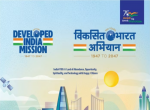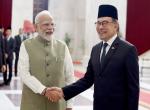The First World War was deemed to be the war to end all wars. Just twenty years after the end of World War I we were engulfed by the Second World War, fought with weapons far more destructive than those used in the period 1914-1919. These included the weapon to end all weapons, the atomic bomb. The war which succeeded the war to end all wars did not create in its wake a world which realised the folly of killing itself off with weapons which could destroy the globe itself. Instead we embarked on a fresh confrontation between the communist world led by the Soviet Union and the so-called free world led by the United States of America. Protagonists of both sides hastened to arm themselves with both conventional and nuclear weapons to an extent where if one button had been pressed in panic mankind itself would evaporate in the heat of a nuclear holocaust. The balance of terror itself acted as a deterrent to actual shooting war, other than various little wars which are euphemistically clubbed together as low intensity conflict. Considering the horrendous casualties suffered in these so-called low intensity engagements one shudders to think what a major conflict would impose on mankind.
The end of the Second World War did not see nations disarming themselves. Instead the tension between East and West led to a frenetic arms race in which nations which cannot feed themselves still spend vast sums of money on arming themselves. Prior to the First World War and right up to the Second World War a gentleman called Zaharoff was considered the merchant of death because he was the biggest arms dealer in the world. In today’s world Zaharoff would be about the equivalent of a street corner vendor selling roasted peanuts from his hand cart. The Cold War, the rivalry between and within the newly liberated colonies, the stand off between America and Russia, Stalinism in one bloc and Macarthyism in the other gave rise to a mutual fear syndrome in which development of weaponry became one of the main purposes of government. A new term, “weapons of mass destruction”, was coined to describe both the new weapons which had massive destructive power and the delivery systems which could carry these weapons to the enemy and destroy him. A clear divide between the past and present was that whereas in the past an arrow or a musket bullet kill the target, rapid fire weapons like a machinegun could lay down a curtain of lead and cannon firing of high explosive shells could cut swathes of destruction, but within a limited range, the new weapons could be delivered up to long distances of even thousands of miles and had the power to destroy entire cities.
Every nation, instead of doing what is right by sitting across the table and then hammering out a solution which all nations voluntarily accepted and disarming in matters of war materials, the exact opposite happened and the arms race began.
Alfred Krupp was the quintessential arms manufacturer who sold excellent artillery pieces to both sides in any conflict. The Lee Enfield Rifle of the British and the Mauser Rifle of the Germans were available to both rebel and government forces, to both friend and foe. Today there are so many Krupps in the world, including Boeing, Lockheed Martin, Dassault and the consortium which manufactures top end weapons platforms which can carry a fearsome array of ordnance and play havoc with opponents.
The logic of arming oneself is that if one’s rival, enemy or future adversary is arming himself, then one will be vulnerable to a superior force unless one has acquired weapons which are more destructive than those of one’s rival. To justify such weapons acquisition one has to have an enemy, or potential enemy, who poses a threat. If an enemy does not exist he has to be created because behind the façade of arming oneself as a defensive measure lies a whole sordid story of inducement, enticement, seduction, fabrication of facts and deliberate falsehood, together with the wholesale erosion of a nation’s values through a massive conspiracy aimed at corrupting the leadership.
Let us take the example of India and Pakistan. The partition took place, both induced by and welcomed by Pakistan and accepted with deep regret by India. The partition left Pakistan dissatisfied because Jinnah described it as “moth eaten”. There was no Islamic corridor between West Pakistan and East Pakistan, nor did Pakistan acquire the lebensraum to accommodate all the new migrants, leave alone all the Muslims of the sub-continent. That drove Pakistan into the Kashmir misadventure, the conspiracy to create an independent, Muslim ruled enclave within India, Hyderabad and within Pakistan gave rise to a hate campaign in which India was projected as an enemy whose sole objective was to destroy Pakistan. That India has accepted Pakistan as a reality is proved by the fact that whether it is in Jammu & Kashmir, West Pakistan or, for that matter, East Pakistan, India has never tried to grab the territory of Pakistan, notwithstanding the three wars we have fought and the subsequent Kargil incident. India is not happy about Pakistan going nuclear, becoming more radically Islamised or being wracked by increasing internal conflict. However, our posture visa-a-vis Pakistan is and will remain defensive as we have no intention of attacking that country. Even in the 1971 war when Pakistan lay prostrate before us we neither made territorial gain nor used almost a lakh of Pakistani troops as a bargaining chip for a treaty of friendship, nor imposed any conditions on either Pakistan or Bangladesh. In fact we withdrew our forces from Bangladesh in the shortest possible time and even at the cost of having an increasing hostile country on our eastern border we have never dictated terms to that country. These points are made to reinforce the argument that India is neither the enemy of Pakistan, nor is desirous of either imposing its will on that country or of taking over any parts of that country. So much so that in 1965 and 1971, when we could have easily recovered at least the lost territory of Jammu & Kashmir, we made no attempt to do so and even evacuated the strategic Haji Pir Pass as part of the Tashkent Agreement. India wants to be safe from low intensity conflict initiated by Pakistan, but we have no ambition to either influence the government of Pakistan through domination, or to acquire Pakistani territory.
In Pakistan the exact opposite is true. Very early in its life as an independent nation the Pakistan Army took over power and has continued to dominate government. This is true even when there is a nominal civilian government in Pakistan, for example now. The Pakistan Army has used two excuses for its dominant role. The first is that the political establishment is corrupt, inefficient and inimical to the genuine interests of the nation. The army, on the other hand, is organised, honest and focused on the need to bring genuine development. The second argument is that Pakistan faces enemies in this world and has to defend itself and the only shield between Pakistan and its enemies is the army. Therefore, the army is the only institution to be trusted in Pakistan and it must be both strengthened and respected. Who is the enemy? Obviously, it is India. Therefore, the Pakistan armed forces must be stronger than those of India, for which they need weapons for the soldiers and corner plots in desired urban locations for its Generals. In fact there is a joke that when in a meeting a General was asked what he thought of the F-16, he said that he would accept it provided it was a corner plot.
The Pakistan Army works in devious ways. To its own people India is represented as their enemy and it itself is projected as the saviour. At the same time the army knows that the Pakistan economy cannot sustain a continuous rearming of the Pakistan army and, therefore, it has played on American fears right from the days of the Cold War. By projecting itself as a pivot for the security of West Asia and Central Asia Pakistan has been able to acquire American weaponry. The Soviet invasion of Afghanistan gave Pakistan greater leverage with America because it offered itself as a launching pad, first for the Mujahiddeen and then for the Taliban against the pro-Soviet Kabul regime and the Northern Alliance. Now the Pakistan Army is playing a two-faced game of supporting America’s war against terror while simultaneously nurturing the Taliban, possibly as a future anti Indian force. This has brought Pakistan more weapons. It is also cleverly playing the China card, from which country it has obtained its nuclear weapons, its missile technology and other weapons for its Air Force and Army. America, as is to be expected, is stupidly playing a game in which it arms Pakistan, ostensibly against terrorism, but with the full knowledge that the weapons will be used against India, while at the same time wooing India as an economic partner and a factor in the containment of China. The net result is that what Pakistan is getting is certainly not sling shots. Pakistan is no David and India is no Goliath. Where does that leave India?
Our real long term worries lie to the east of Himalaya in our giant neighbour, China, which refuses to acknowledge the boundaries between India and China. China has territorial ambitions in Ladakh, Sikkim and Arunachal Pradesh. In 1962 it asserted its authority by a short and sharp war which had India on the ropes. Of course Major General Sagat Singh, later Lieutenant General, restored some balance in 1967 by teaching the aggressive Chinese a short and sharp lesson at Nathu La. Since then India has been relatively passive on the Chinese border when dealing with transgressions. Unfortunately our real hot border at present is with Pakistan and so long as the Pakistan Army is not destroyed in battle and loses its credibility as the guardian of Pakistan, we shall always have to be wary of it. That is why the Indian Armed Forces need modern weapons in sufficient quantity to enable us to dominate the Pakistan Army even in a nuclear environment. The Artillery needs guns and the Cavalry needs tanks, the Air Force needs modern combat aircraft and the Navy needs an adequate strength of warships to enable it to dominate the Arabian Sea and neutralise China in the Indian Ocean. That is why the axiom that guns are better than sling shots!
Why is our weapon acquisition so dilatory, so over shadowed by fear that someone will allege corruption? The acquisition of weapons involves such vast sums of money that whoever does not get an order will always make wild allegations to render the process itself null and void. We are over cautious in this behalf, especially after the Jeep scandal when V.K. Krishna Menon was High Commissioner in London and the Bofors scandal when Rajiv Gandhi was Prime Minister. This despite the fact that the Bofors 155 mm gun is one the finest pieces of artillery ever designed and it is the weapon which won us the Kargil War. The whole process of buying weapons is tied up in such knots that nothing moves. Therefore, lest we be saddled with only sling shots and quarter-staves we have to streamline the procurement procedure. It is suggested that the following procedure may be adopted, each step of which has to be completed within a pre-determined time frame in which each tranche of time is defined and kept within reasonable limits.
- There has to be long-term planning about the shape of our armed forces and their weaponisation, keeping in mind our long term strategic interests.
- The Chief of each Service must determine what weapons are needed at a given point of time. He must arrange for their location and their testing with a view to short-listing the systems which are appropriate. The Service Chief must then convince government or, if there is a Chief of Defence Staff, then that officer and through him the government of the need of the weapon system, the trials already conducted and the results of the trials. A cost estimate must be appended.
- Government must then decide on acquisition, including quantity and the financial implications. If the government is convinced, then it should direct the Service Chief to go ahead with acquisition. For this purpose it must make available the budget and place it at the disposal of the Service Chief.
- The procedure for acquisition must be duly laid down by government and must form part of the procurement manual. The process of tendering and evaluation of tenders must be prescribed, transparent and available for inspection without compromising security. For this purpose there can be a procurement committee in each Service Headquarters in which the Ministry of Defence and the Ministry of Finance may both be represented. Once the Chief has accepted the recommendations of the committee the order of purchase must issue and the file need not come back to the Ministry. It is only when the procurement is completed that the Chief will give a detailed report to the Ministry on the whole process and will also certify that the requisite weapons have been received in good order.
We have very high powered Service Chiefs who are appointed though a rigorous process of selection. We trust the Service Chiefs to defend our country and conduct wars. Why can we not trust them in the matter of acquisition of weapons? Let us not retain untrustworthy Chiefs, but if we have a Chief let us trust him. In any case the procedures of government do not give much leeway to errant officers and there is always subsequent accountability both to audit and to government. The new procedure will not encourage corruption as is the generally expressed fear. What it will do is to speed up the process which, in itself, reduces corruption because there is no delay and it will ensure that at all times our armed forces have the weapons they need to keep our country secure.
Published Date : 06th February 2012









Post new comment